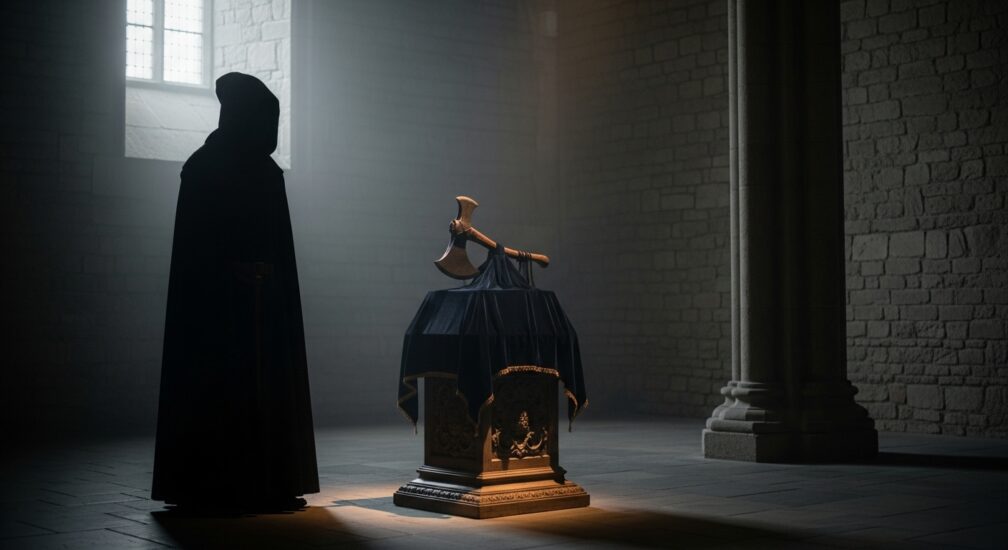Stepping into the shadowy role of a medieval executioner unveils a world of paradox: they were both feared and necessary, reviled and respected. Despite the grim nature of their work, executioners held a unique position in society, their lives shrouded in mystery and marked by complex duties.
The Role and Responsibilities of a Medieval Executioner
The executioner’s job was not merely about swinging an axe or igniting a pyre. Executioners carried out sentences handed down by courts, ensuring justice was served in accordance with the law. Their duties extended beyond executions to tasks such as interrogations, administering torture, and even disposing of bodies.
Despite their feared reputation, executioners had a methodical approach to their work, adhering to strict rituals that underscored the solemnity of their role in the justice system. Explore the tools of their trade and the societal backdrop of their profession at the Medieval Torture Museum in Chicago.
The Iconic Hooded Outfits: Why Did Executioners Wear Hoods?
A question often asked is, why did executioners wear hoods? These hoods served both practical and symbolic purposes. By concealing their identity, executioners shielded themselves and their families from potential revenge or scorn. The hood also reinforced the idea that the executioner was an impartial agent of justice, carrying out the will of the court, not acting on personal vendettas.
In addition to hoods, the medieval executioner outfit included durable, dark clothing, often designed for ease of movement and to minimize bloodstains. The mysterious appearance added to their aura, aligning with the rituals surrounding capital punishment. Learn more about this cultural and historical significance at the Medieval Torture Museum in LA.
Compensation for a Grim Profession: How Much Did Executioners Make?
Curiously, how much do executioners make was a matter of societal standing and local traditions. Executioners often earned a combination of fixed wages, additional fees for specific tasks, and tips from grateful families who sought swift or merciful executions. Their income, while sometimes substantial, came at the cost of social isolation, as many viewed them as tainted by their grim work.
Despite their marginalization, executioners wielded significant authority, and their services were indispensable in maintaining societal order. If you’re intrigued by the economics of justice in the Middle Ages, visit the Medieval Torture Museum in St Augustine to delve deeper into the lives of these enigmatic figures.
The Rituals and Secrets Behind the Mask
Beyond the hood, why did executioners wear masks? Masks served as another layer of anonymity and a tool for distancing the person from the act. The executioner became a symbol of justice rather than an individual, emphasizing the gravity of the event. Masks often featured neutral or intimidating designs, further heightening the theatricality of the execution.
The rituals surrounding executions were steeped in tradition, with specific prayers, announcements, and gestures that transformed these acts into public spectacles. The executioner’s role was not only to carry out justice but also to embody its authority.
From Medieval Justice to Modern Curiosity
The legacy of the medieval executioner continues to captivate modern audiences. Whether you’re exploring their tools, techniques, or societal role, the profession offers a fascinating glimpse into the interplay between justice and culture.
For history enthusiasts, visiting the blog of the Medieval Torture Museum provides a wealth of resources and engaging insights into this dark yet intriguing chapter of human history.
And for those seeking fun activities in Los Angeles, the Medieval Torture Museum offers an immersive experience where you can explore artifacts and stories from this shadowy profession. It’s an unforgettable journey through the rituals, symbols, and secrets of medieval justice.
The life of a medieval executioner was one of contrasts. Their work, while grim, was essential to the justice system. Through their hooded anonymity and adherence to tradition, they embodied both the authority and the mystery of medieval culture. Their legacy remains a testament to the complexities of justice and the human condition.






